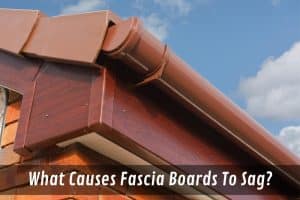For more information on any of the services offered by High Class Roofing or a free no obligation quotation, please complete the following form or call us on 0405 229 765.
What Causes Fascia Boards To Sag?

The roof fascia board is an essential part of a building’s roofing system. It is designed to protect the roof edge from water deterioration and provide a finished look to the roofline. However, over time, these boards can start to sag, which can compromise the structural integrity of the roof. In this blog post, we will explore the reasons why roof fascia board sag and what you can do to prevent this issue from occurring. Whether you are a homeowner or a contractor, understanding the root causes of fascia board sagging can help you take the necessary steps to maintain a safe and durable roofing system. So, let’s dive in and discover what causes fascia boards to sag!
What is a fascia board?
A fascia board is a long, straight board that is installed along the lower edge of the roof, just below the roofline. It is typically made of wood, plastic or metal, and it runs horizontally along the roof’s edge, attached to the end of the roof rafters or trusses.
The main function of a fascia board is to provide a surface for attaching the gutters to the roof, as well as to cover and protect the ends of the roof rafters or trusses from the elements. In addition, it can also enhance the appearance of a building’s exterior by creating a smooth, even appearance along the roofline.
Fascia boards can be made of different materials depending on the requirements of the building, and they come in various sizes and shapes to suit different roofing designs. It is an essential component of a roof system and helps to protect the roof from water deterioration, insects, and other types of wear and tear.
What are some common signs that the roof fascia board is sagging?
Sagging roof fascia boards can be difficult to detect at first, but there are a few common signs that can indicate that there is an issue with your fascia board. Here are some of the most noticeable signs that you may have a sagging roof fascia board:
-
Visible sagging
One of the most obvious signs of a sagging fascia board is a visible dip or sag in the roofline. You may notice a section of the roofline that appears to be lower than the rest of the roof, which can indicate that the fascia board is sagging.
-
Water damage
If you see water stains or discolouration, this may be a sign that the board is malfunctioning. Sagging fascia boards can allow water to seep behind the gutters and into the roof, causing water damage to the roof decking and other structural components.
-
Separation from the roofline
In severe cases, a sagging board may begin to separate from the roofline altogether. You may notice gaps between the fascia board and the roof decking, which can allow pests and debris to enter the roof cavity.
-
Gutter problems
It can cause gutters to pull away from the roofline, resulting in improper water drainage. You may notice that your gutters are overflowing or leaking, which can lead to water damage to the roof and the building’s foundation.
If you notice any of these signs, it’s important to address the issue as soon as possible to prevent further damage to your roof and building. Contact a professional roofing contractor to inspect your fascia board and recommend the best action.
What are the reasons behind the sagging of the roof fascia board?
- There are several reasons why roof fascia boards may sag over time. One of the most common reasons is water damage. If the fascia boards are made of wood and are exposed to moisture for an extended period, they can rot and weaken, leading to sagging. This can be caused by clogged gutters, which prevent water from flowing properly and result in water accumulation that can damage the fascia board.
- Additionally, if the gutter system is not installed properly or the gutter brackets, hangers, screws, or spikes are loose, it can cause excessive weight on the fascia board, leading to sagging.
- Water weight during heavy rain or snow can also cause the fascia board to sag. Similarly, the weight of larger gutters or an entire gutter system can be too much for the fascia board to support, causing it to sag. Tree branches that hang over the roofline can also be a culprit, adding extra weight to the fascia board.
- In addition to water damage and weight issues, fascia boards can also sag due to structural issues with the roof decking, roof rafters, or the roof structure itself. Rotted fascia boards can also be a problem, especially if they are not repaired or replaced promptly. These issues can be costly to fix and can cause foundation damage from water accumulation or water leaks.
- Sagging fascia boards can also affect the curb appeal of a building. Leaky gutters, gutter overflow, and water stains can make the building look unappealing and can lead to costly damage if not addressed by a gutter professional or a gutter repair specialist.
What are some tips on how to prevent the sagging of a roof fascia board?
Preventing the sagging of your fascia board is crucial to maintaining the structural integrity of your roofline. Here are some tips to help prevent fascia board sagging:
-
Install seamless gutters
Seamless gutters have fewer joints and are less likely to leak or overflow. It reduces the risk of water damage to your fascia board.
-
Install larger gutters
Installing larger gutters can help prevent water accumulation and reduce the weight on the fascia board.
-
Ensure proper slope
Make sure that your gutter system is properly sloped. This allows water to flow freely and prevents water accumulation that can cause fascia board damage.
-
Install gutter guards
Gutter guards can help prevent clogs and debris buildup in your gutters. It reduces the risk of water damage and weight issues.
-
Regular gutter cleaning
Cleaning your gutters regularly can prevent clogs and the buildup of debris. It will reduce the risk of water damage to your fascia board.
-
Trim tree branches
Trimming tree branches can help reduce weight and prevent damage to the fascia board.
-
Use waterproof caulk
Applying waterproof caulk around the edges of your fascia board can help prevent water from seeping in and causing damage.
-
Repair or replace rotted fascia boards
Promptly repairing or replacing rotted fascia boards can prevent further damage to the roofline and prevent sagging.
-
Hire a professional
A gutter professional or a roofing contractor can perform an inspection and provide recommendations on how to prevent fascia board sagging.
By following these tips, you can help prevent fascia board sagging and maintain the structural integrity of your roofline.
In conclusion, there are several reasons why fascia boards may sag. It includes water damage, excessive weight from gutters or debris, structural issues, and rotting. Preventative measures, such as regular gutter cleaning, installing larger or seamless gutters, and trimming tree branches, can help reduce the risk of fascia board sagging. Promptly repairing or replacing damaged or rotted fascia boards is also essential to prevent further damage to the roofline. By understanding the common causes of fascia board sagging and taking steps to prevent it, homeowners can ensure the longevity and structural integrity of their roofs.
Looking to enhance the appearance and functionality of your roof? Contact High Class Roofing today and take the first step towards a beautiful, durable, long-lasting roofing solution. Our team of experienced professionals is dedicated to providing top-quality roofing assistance that exceeds your expectations.

